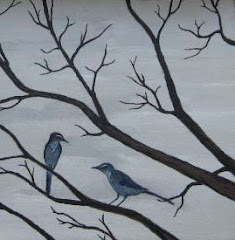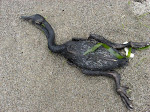
My favorite landmark of Pacific City, Oregon is Haystack Rock.

Wherever you are in town, this massive island peak is hard to miss when the weather is not too cloudy or foggy.
Sixty miles to the north in Cannon Beach, Oregon, lies another Haystack Rock, pictured below.

Both rocks are of volcanic origin and are protected as Wildlife Refuges.
Cannon Beach’s rock is smaller that Pacific City’s and is located closer to the shore. At low tide, you can walk to the base of the Cannon Beach Rock to look for tide pool creatures and a variety of shorebirds.

This rock is one of the most reliable places in the state to find tufted puffins and harlequin ducks.

Pacific City’s rock is about a mile away from the shore, so the birding is not as easy. Regardless, this rock is a great place to see large numbers of birds throughout the year. During the summer, the rock is an important nesting site for hundreds, if not thousands, of seabirds.

Western gulls appear to nest on the gently sloping southeastern face.

Large cormorants, either double-crested or Brandt’s, occupy the rocky areas near the top of the rock.

The smaller pelagic cormorant builds platform nests on ledges of vertical cliffs, closer to the water. Some years, I see common murres packed onto some ledges as well, where they are probably nesting too.

Pigeon guillemots likely find spaces to nest in small caves on the north face of the rock. There are some patches of grass there as well where tufted puffins, rhinoceros auklets, and storm-petrels may dig burrows for their nests. Since I am limited to viewing the rock by through a spotting scope, I’m not sure if all of these birds are currently nesting out on the rock, but I like to think they are.

During the winter, Pacific City’s rock is a popular roost for gulls, cormorants, and other seabirds.

In spring, summer, and fall, Brown Pelicans roost near the top of the rock and at its base. Every once in a while, I spot a California seal lion hauled out near the base at low tide.
It seems like there is always something going on at Pacific City’s Haystack Rock and we are lucky to have such a great view.

 While surveying Bob Straub State Park for beached seabirds, we observed an American Crow employed in a grisly foraging tactic.
While surveying Bob Straub State Park for beached seabirds, we observed an American Crow employed in a grisly foraging tactic. It was pulling Pacific mole crabs from the sand and snapping off their tails, which are used to cover bright orange egg masses.
It was pulling Pacific mole crabs from the sand and snapping off their tails, which are used to cover bright orange egg masses.










































